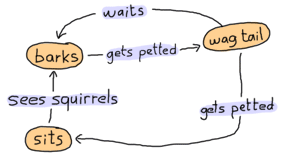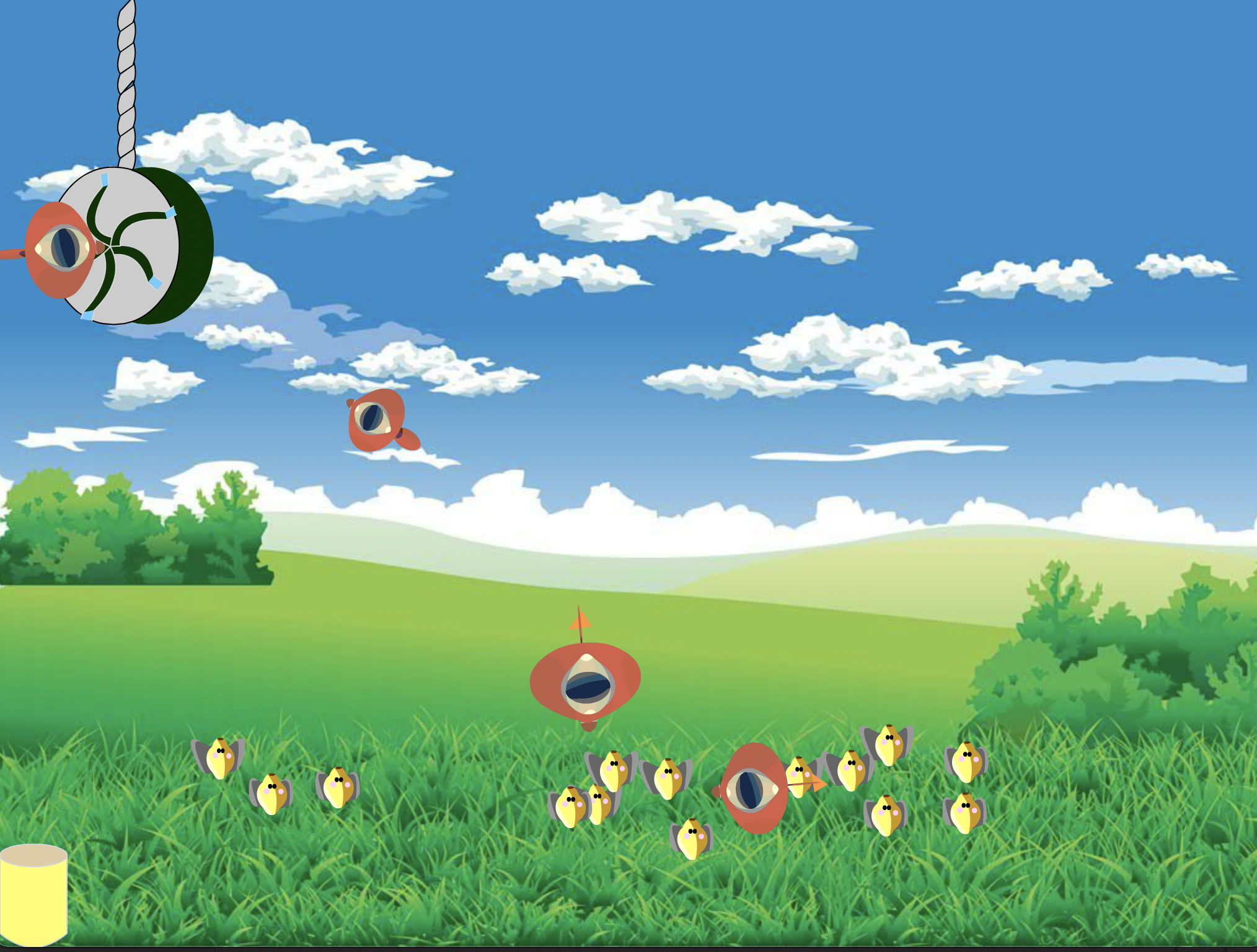Week 8 - Arrays of Objects and Debugging
Note: We will take breaks at least once an hour
Today’s Schedule
- check-in
- midterm
- arrays of objects
- finite state machine
Midterm Exam
Arrays of objects
Several weeks ago we built Frogger in class. We created a Car class and then built a number of car objects (car0, car1, car2, etc). What do these objects have in common?
This is a perfect use case for an array. Especially if we want to make a large number of cars.
Let’s re-use our car class:
class Car {
float x;
float y;
float xspeed;
color c;
Car(float tempX, float tempY, float tempXspeed, color tempC){
c = tempC;
x = tempX;
y = tempY;
xspeed = tempXspeed;
}
void display(){
rectMode(CENTER);
stroke(0);
fill(c);
rect(x, y, 20, 10);
}
void move(){
x = x + xspeed;
if (x > width){
x = 0;
}
if (x < 0){
x = width;
}
}
}
Let’s say we have 2 cars.
Our main code:
Car car0, car1;
void setup(){
size(500,500);
car0 = new Car(100,150,1,color(100,0,100));
car1 = new Car(300,230,2,color(220,0,120));
}
void draw(){
background(255);
car0.display();
car0.move();
car1.display();
car1.move();
}
What happens if we have more than 2 cars. What if we have 10 cars? 30 cars?
It would be a lot easier if we didn’t have type in all of the cars individually.
Car[] cars = new Car[20]; //an array of 20 cars
void setup(){
size(500,500);
for (int i = 0; i < cars.length; i++){
cars[i] = new Car(random(width),random(height),random(2),color(random(255)));
}
}
void draw(){
for (int i = 0; i < cars.length; i++){
cars[i].display();
cars[i].move();
}
}
Debugging
Processing comes with a Debugger.
What’s a bug?

an error, flaw, failure or fault in a computer program or system that causes it to produce an incorrect or unexpected result, or to behave in unintended ways. Wikipedia
Bugs cause disasters:
- The Challenger spaceship explosion
- European Space Agency’s $1 billion Ariane 5 rocket was destroyed a minute after launch due to a bug in the guidance program
- stuck accelerator in certain Toyota cars
Using Processing’s Debugger
- Turn on the debugger (Debug menu or click the Moth icon)
- Click on the line where you want to set a breakpoint (a pause when running the code)
- Choose Set Breakpoint from the Debug menu
- Run your code. It will pause at the breakpoint and show your variables.
- You can hit step to move one line of code, or continue to run until the next breakpoint
- You can set multiple breakpoints. You can click on the Processing folder to see builtin variables.
Finite State Machines
A few weeks ago we looked at diagrams of finite state machines.


Today, we will code one.
At its core, the finite state machine are a series of functions with different states. You can transition between these states. And you can never be in more than one state at a time.
void draw(){
if (state == "sleeping"){
sleeping();
} else if (state == "laughing"){
laughing();
} else if (state == "eating"){
eating();
} else {
sitting();
}
}
Basic finite state machine example
String state = "sleeping";
void setup(){
}
void draw(){
if (state == "sleeping"){
sleeping();
} else if (state == "eating") {
eating();
} else {
sitting();
}
}
void sleeping(){
println("It's sleeping");
if (mousePressed){
state = "sitting";
}
}
void sitting(){
println("It's sitting");
if (mousePressed){
state = "eating";
}
}
void eating(){
println("It's eating");
if (mousePressed){
state = "sitting";
}
}
Next steps:
Now we add in:
- drawing
- timers
- interactivity
Midterm project checkin
- work on midterm project
- Midterm project is due on Oct 26
For next week:
Prototype of virtual pet due.
Your prototype must include:
-
- flowchart of finite state machine and 2. your code
- Code all states from your submitted finite state machine flowchart. Your code must reflect on the states and triggers from your finite state machine flowchart
- Implementation of all triggers and states (triggers are the events that transition between states)
- compelling visuals of the pet to accompany each of its states (consider how you can animate as well)
- completion of interactivity and timers between states
Grading Rubric for final of virtual pet project:
Code
- Your project’s code should be well-commented. Variables, functions and class names should be clear. Classes should be on their own separate tab.
- Your coding should be efficient. Break your code into meaningful chunks using functions and classes. Rather than repeat code, use loops. Consider how arrays might help your code.
- Your code should work!
- Don’t hard code numbers. Use variables, width, height - for example - to make your code function on different computers.
Idea
- Your software should be accompanied by a description (more than a paragraph, less than a page. What is the idea? How did you approach it? What challenges did you have? How did you solve it? These are example questions. Feel free to add additional information.
- Did you base your functionality on other virtual pets, animals, Aibo, something else?
- What feedback did you receive on your prototype? What changes did you make based on that feedback?
- Your originality will be judged. Do not copy projects already found online.
Functionality and Design
- Is it clear how to use and navigate your virtual pet? Remember K.I.S.S. principles (“Keep It Simple, Stupid!”)
- How do you interact with it?
- Does the program flow (of your finite state machine) make logical sense?
- Do the aesthetics suit the concept? Is it engaging more than a minute? Is the interaction compelling for users?
- How does the virtual pet show that it’s passing time?
- A complete virtual pet must include both timers as well as interactivity (mouse or keys).